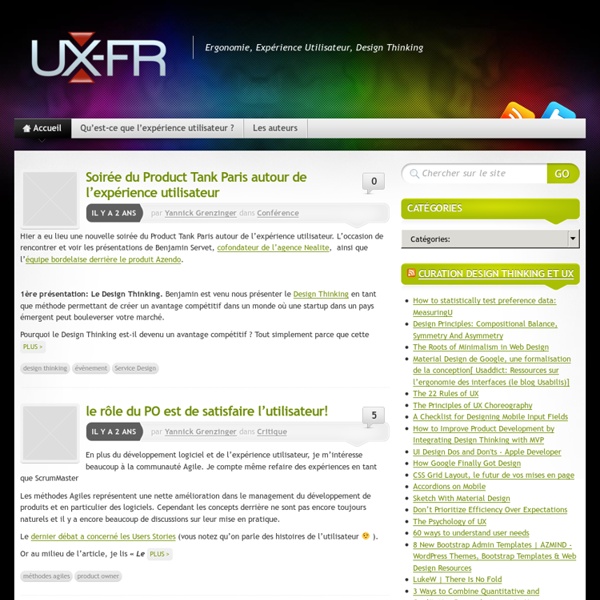



“Right click and save as” needs to go away For a long time it has been standard practice to ask visitors to “right click and save as” when downloading a file that the browser itself is capable of rendering, but where doing so is not desirable. One reason for doing this is to spare people from the annoying experience of accidentally clicking a link to a 25 MB PDF, which subsequently launches a browser plugin that of course crashes while trying to download and display the file. From a UX perspective though, adding instructions on how to click a link is not optimal, and feels like a hack. Not to mention that lots of people are literally afraid of the right mouse button.
Mais que veulent dire les abréviations UX, UI et GUI ? Oups ! La page n'existe pas :( Agence Quatrepointzero Facebook How to Deal with Images on the Web - Web Design Usability Guide They say a picture is worth a thousand words. True or not, images are an important part of any website we create. Since it is so easy to embed an image in a website (even the process of creating your own images is very easy), most websites are filled with them. There are some very good examples out there on how to deal with images in a website from different points of view, but most of the websites do not showcase positive examples. And while this is not entirely dangerous for a design, it might decrease your chances to sell, in case you have a call-to-action page, or the chances to create good reading flow.
Cheat Sheet Download cheat sheet as printable PDF A5 Syntax Child: > nav>ul>li Sibling: + Why the Flat Design Trend is Hurting Usability The flat design trend has taken over the graphic design world in a very short amount of time. One of the first big interfaces to go flat was Windows 8. However, it wasn’t until the release of Apple’s iOS 7 last summer, June 10, 2013 that we really saw a huge increase in the many interfaces, websites, apps, and more that adopted a flat design. Before then, most designs were skeuomorphic with lots of 3D effects, gradients, and texture. The look is both trendy and modern, and the new design trend is still surrounded by a buzz. But not all of the buzz is positive.
WAI-ARIA Overview Quick links: WAI-ARIA, User Agent Implementation Guide, FAQ See also FAQ: What is the current status of WAI-ARIA development? Introduction WAI-ARIA, the Accessible Rich Internet Applications Suite, defines a way to make Web content and Web applications more accessible to people with disabilities. It especially helps with dynamic content and advanced user interface controls developed with Ajax, HTML, JavaScript, and related technologies. Web Squared: Web 2.0 Five Years On - by Tim O'Reilly and John Battelle Five years ago, we launched a conference based on a simple idea, and that idea grew into a movement. The original Web 2.0 Conference (now the Web 2.0 Summit ) was designed to restore confidence in an industry that had lost its way after the dotcom bust. The Web was far from done, we argued. In fact, it was on its way to becoming a robust platform for a culture-changing generation of computer applications and services.
Schema.org Most webmasters are familiar with HTML tags on their pages. Usually, HTML tags tell the browser how to display the information included in the tag. For example, <h1>Avatar</h1> tells the browser to display the text string "Avatar" in a heading 1 format. However, the HTML tag doesn't give any information about what that text string means—"Avatar" could refer to the hugely successful 3D movie, or it could refer to a type of profile picture—and this can make it more difficult for search engines to intelligently display relevant content to a user.
RESS: Responsive Design + Server Side Components There's no shortage of debate about the best way to develop Web sites that work well across many networked devices. Some teams favor a client-side approach while others lean towards server-side solutions. But I'm increasingly interested in solutions that try to bring together the best of both worlds. Cascading Style Sheets Level 2 Revision 1 (CSS 2.1) Specification This specification defines Cascading Style Sheets, level 2 revision 1 (CSS 2.1). CSS 2.1 is a style sheet language that allows authors and users to attach style (e.g., fonts and spacing) to structured documents (e.g., HTML documents and XML applications). By separating the presentation style of documents from the content of documents, CSS 2.1 simplifies Web authoring and site maintenance. CSS 2.1 builds on CSS2 [CSS2] which builds on CSS1 [CSS1].
The Best Freebies for Designers (June 2013) Here are the best freebies for designers from June 2013. We have free GUI templates, icon sets, fonts, Photoshop brushes, PSD templates, textures… and everything else inbetween. Freebies for Designers – June 2013: Icon Sets